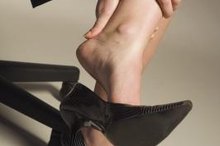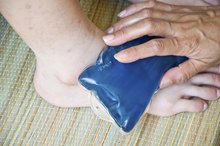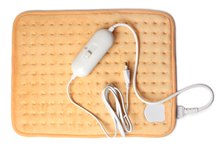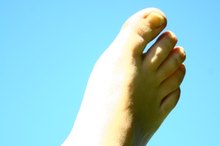My Heel Hurts & I Have Sharp Pain When I Walk
When you step forward and hit your heel to the ground in walking, it is referred to as the heel strike. A great deal of force goes through your heel and ankle during walking and each heel strike. If you have an injury such as Achilles tendinitis or plantar fasciitis, walking may become quite painful. To decrease pain and inflammation, rest, ice and take over-the-counter pain medications. If your pain worsens, consult your physician.
If you are experiencing serious medical symptoms, seek emergency treatment immediately.
Achilles Tendinitis
A tight calf muscle can pull on your Achilles tendon, which attaches to the back of your heel. The constant pulling can irritate and inflame your Achilles tendon, causing tendinitis. Symptoms include swelling, stiffness and pain, especially where your Achilles tendon inserts on your heel. Pain is often worse during flexion of your foot or toe push-off in walking, according to a 2004 "American Family Physician" article 12. Over time, your Achilles tendon can become thick and weak, increasing your risk of tearing your tendon during activities like walking.
- A tight calf muscle can pull on your Achilles tendon, which attaches to the back of your heel.
Plantar Fasciitis and Bone Spurs
What Causes Pain to the Back of Your Ankle & Heel When You Walk?
Learn More
Your plantar fascia is tissue that is located on the bottom of your foot from your toes to your heel. It helps support your foot and arch during weight-bearing activities. High-impact exercises such as running, over-training, and shoes with inadequate arch support can lead to inflammation of your plantar fascia, causing plantar fasciitis. Walking, especially when you first get up in the morning can cause severe heel and foot pain. Chronic plantar fasciitis can also cause a bone spur, which is a bony projection that develops off of your heel. A bone spur may further increase heel pain during activities like walking.
- Your plantar fascia is tissue that is located on the bottom of your foot from your toes to your heel.
- High-impact exercises such as running, over-training, and shoes with inadequate arch support can lead to inflammation of your plantar fascia, causing plantar fasciitis.
Additional Causes
A stress fracture on your heel, tarsal tunnel syndrome and bursitis are additional injuries that can cause significant heel pain, especially during walking or running. A stress fracture is a small crack in your heel bone and may develop due to over-training in high-impact activities such as running and jumping. Tarsal tunnel syndrome is when your nerve is compressed on the back of your ankle and heel, resulting in heel pain and numbness or tingling. Lastly, bursitis is inflammation of your bursa sac -- a sac of fluid located underneath tendons to reduce friction. When tendons such as your Achilles tendon become tight and inflamed, you may develop bursitis.
- A stress fracture on your heel, tarsal tunnel syndrome and bursitis are additional injuries that can cause significant heel pain, especially during walking or running.
- Lastly, bursitis is inflammation of your bursa sac -- a sac of fluid located underneath tendons to reduce friction.
Treatment and Prevention
Foot Pain When First Walking in the Morning
Learn More
Your physician may also recommend using crutches during walking, physical therapy and surgery. Additional treatments to consult your physician about include:
- corticosteroid injections
- orthotics
- immobilization in a walking boot,
- a night splint
- which is a boot worn at night to keep your foot in extension
A 2007 “Clinical Review” article advises to use precaution, however, with corticosteroid injections due to possible negative side effects like infection. To prevent heel pain, stretch your foot, ankle and calf regularly; allow plenty of recovery between high-impact workouts; and wear shoes with plenty of arch support.
Related Articles
References
- “American Family Physician”; Diagnosing Heel Pain in Adults; Tracy Aldridge, M.D.; July 2004
- “American Family Physician”; Tendinopathies of the Foot and Ankle; Michael R. Simpson, D.O., et al.; November 2009
- “Journal of Multidisciplinary Healthcare”; Plantar Fasciitis – to Jab or to Support? A Systematic Review of the Current Best Evidence; Hayley Uden, et al.; May 2011
- “Clinical Evidence”; Plantar Heel Pain and Fasciitis; Karl B Landorf, et al.; January 2007
- American Academy of Orthopedic Surgeons. (2017). Heel Pain. https://orthoinfo.aaos.org/en/diseases--conditions/heel-pain
- Tu P, Bytomski JR. Diagnosis of Heel Pain. Am Fam Physician. 2011 Oct 15;84(8):909-16. https://www.aafp.org/afp/2011/1015/p909.html
- Tu P, Bytomski JR. Diagnosis of heel pain. Am Fam Physician. 2011;84(8):909-16.
- Lim AT, How CH, Tan B. Management of plantar fasciitis in the outpatient setting. Singapore Med J. 2016;57(4):168-70. doi:10.11622/smedj.2016069
- Li HY, Hua YH. Achilles Tendinopathy: Current Concepts about the Basic Science and Clinical Treatments. Biomed Res Int. 2016;2016:6492597. doi:10.1155/2016/6492597
- Gulati V, Jaggard M, Al-nammari SS, et al. Management of achilles tendon injury: A current concepts systematic review. World J Orthop. 2015;6(4):380-6. doi:10.5312/wjo.v6.i4.380
- Hong CH, Lee YK, Won SH, Lee DW, Moon SI, Kim WJ. Tarsal tunnel syndrome caused by an uncommon ossicle of the talus: A case report. Medicine (Baltimore). 2018;97(25):e11008. doi:10.1097/MD.0000000000011008
- Mayer SW, Joyner PW, Almekinders LC, Parekh SG. Stress fractures of the foot and ankle in athletes. Sports Health. 2014;6(6):481-91. doi:10.1177/1941738113486588
- Tu P. Heel Pain: Diagnosis and Management. Am Fam Physician. 2018;97(2):86-93.
- Yi TI, Lee GE, Seo IS, Huh WS, Yoon TH, Kim BR. Clinical characteristics of the causes of plantar heel pain. Ann Rehabil Med. 2011;35(4):507-13. doi:10.5535/arm.2011.35.4.507
- Kucuksen S, Karahan AY, Erol K. Haglund syndrome with pump bump. Med Arch. 2012;66(6):425-7.
- Vaishya R, Agarwal AK, Azizi AT, Vijay V. Haglund's Syndrome: A Commonly Seen Mysterious Condition. Cureus. 2016;8(10):e820. doi:10.7759/cureus.820
- Pękala PA, Henry BM, Pękala JR, Piska K, Tomaszewski KA. The Achilles tendon and the retrocalcaneal bursa: An anatomical and radiological study. Bone Joint Res. 2017;6(7):446-451. doi:10.1302/2046-3758.67.BJR-2016-0340.R1
- Helgeson K. Examination and intervention for sinus tarsi syndrome. N Am J Sports Phys Ther. 2009;4(1):29-37.
- Ma DL, Vano-galvan S. Piezogenic pedal papules. CMAJ. 2013;185(18):E847. doi:10.1503/cmaj.121963
- Fritz JM, Mcdonald JR. Osteomyelitis: approach to diagnosis and treatment. Phys Sportsmed. 2008;36(1):nihpa116823. doi:10.3810/psm.2008.12.11
- Yan L, Zong J, Chu J, et al. Primary tumours of the calcaneus. Oncol Lett. 2018;15(6):8901-8914. doi:10.3892/ol.2018.8487
- Narváez JA, Narváez J, Ortega R, Aguilera C, Sánchez A, Andía E. Painful heel: MR imaging findings. Radiographics. 2000;20(2):333-52. doi:10.1148/radiographics.20.2.g00mc09333
- Thomas JL, Christensen JC, Kravitz SR, et al. The diagnosis and treatment of heel pain: a clinical practice guideline-revision 2010. J Foot Ankle Surg. 2010;49(3 Suppl):S1-19. doi:10.1053/j.jfas.2010.01.001
- Noor S, Khan RU, Ahmad J. Understanding Diabetic Foot Infection and its Management. Diabetes Metab Syndr. 2017;11(2):149-156. doi:10.1016/j.dsx.2016.06.023
- Lui E. Systemic causes of heel pain. Clin Podiatr Med Surg. 2010;27(3):431-41. doi:10.1016/j.cpm.2010.04.004
- Podolsky R, Kalichman L. Taping for plantar fasciitis. J Back Musculoskelet Rehabil. 2015;28(1):1-6. doi:10.3233/BMR-140485
- Habets B, Van cingel REH, Backx FJG, Huisstede BMA. Alfredson versus Silbernagel exercise therapy in chronic midportion Achilles tendinopathy: study protocol for a randomized controlled trial. BMC Musculoskelet Disord. 2017;18(1):296. doi:10.1186/s12891-017-1656-4
- Riskowski J, Dufour AB, Hannan MT. Arthritis, foot pain and shoe wear: current musculoskeletal research on feet. Curr Opin Rheumatol. 2011;23(2):148-55. doi:10.1097/BOR.0b013e3283422cf5
- Donley BG, Moore T, Sferra J, Gozdanovic J, Smith R. The efficacy of oral nonsteroidal anti-inflammatory medication (NSAID) in the treatment of plantar fasciitis: a randomized, prospective, placebo-controlled study. Foot Ankle Int. 2007;28(1):20-3. doi:10.3113/FAI.2007.0004
- Sahu RL. Percutaneous planter fasciitis release under local anesthesia: A prospective study. Chin J Traumatol. 2017;20(2):87-89. doi:10.1016/j.cjtee.2017.01.002
- American Academy of Orthopedic Surgeons. (2017). Heel Pain.
- Buchbinder R. (2018). Patient education: Heel and foot pain (caused by plantar fasciitis) (Beyond the Basics). Isaac Z, ed. UpToDate. Waltham, MA: UpToDate Inc.
- Lareau CR, Sawyer G, Wang JH, DiGiovanni CW. Plantar and medial heel pain: diagnosis and management. J Am Acad Orthop Surg. 2014 Jun;22(6):372-80. doi: 10.5435/JAAOS-22-06-372
- Ma DL, Vano-Galvan S. Piezogenic pedal papules. CMAJ. 2013 Dec 10;185(18):E847. doi: 10.1503/cmaj.121963
- Tu P, Bytomski JR. Diagnosis of Heel Pain. Am Fam Physician. 2011 Oct 15;84(8):909-16.
- Vaishya R, Agarwal AK, Azizi AT, Vijay V. Haglund's Syndrome: A Commonly Seen Mysterious Condition. Cureus. 2016 Oct;8(10):e820. doi: 10.7759/cureus.820
Writer Bio
Since 2007 Hannah Mich has written e-newsletters and been published in the "Missouri Journal of Health, Physical Education, Recreation and Dance." She has a Bachelor of Science in exercise science from Truman State University and a Master of Education in applied kinesiology from the University of Minnesota.









